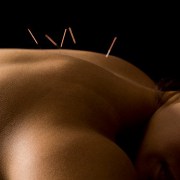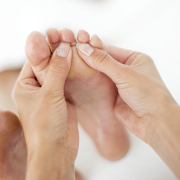Pain in the lower back that radiates down the leg may be diagnosed as sciatica. This condition ranges from mild, with nothing more than tingling sensations, to severe pain that disrupts the patient's sleep and activities. Often it clears up by itself. Conservative treatments include over the counter pain killers, ice, heat, and posture changes. Reference 1 recommends that you sleep with a pillow between your knees in the fetal position, or pillow under the knees if you sleep on your back.
Glucocorticoid steroid shots are a standard treatment for more severe cases. A review article from the Cleveland Clinic explains when and why these may be appropriate. Inflammation is the key. Factors that predict good results from steroid shots are:
1. Pain and tingling radiating down the leg that persists for four to six weeks even with conservative treatment.
2. Back pain associated with leg pain.
3. Pain associated with standing and walking, relieved by sitting.
4. Rest, non-steroidal anti-inflammatories, and initial physical therapy are not adequate.
5. A physical exam including positive straight-leg raising test, radicular pain pattern, and minimal motor deficit points to nerve root irritation or compression.
Steroid shots are not recommended if you have any of these conditions:
1. Ongoing use of anticoagulant medication.
2. Evidence of local infection.
3. Diabetes mellitus.
4. Difficulty in moving severe enough to suggest severe nerve compression.
5. Imaging studies (X-ray or other) demonstrating spinal stenosis.
6. Failure of previous steroid injections to provide benefit.
Other factors that predict a poor outcome from steroid shots are:
1. Chronic pain lasting more than six months.
2. Pain that does not radiate down the leg.
3. Pain that is not increased by activity.
4. Pain increased by cough.
5. Unemployment due to back pain.
6. Greater dependence on pain medication.
7. Greater number of previous treatments for pain.
8. History of smoking.
Glucocorticoid steroids are generally more effective than non-steroidal anti-inflammatories (NSAID) because they inhibit the production of more inflammatory molecules. The NSAID drugs inhibit the action of cyclooxygenase in the production of prostaglandins. Other inflammatory molecules are leukotrienes, produced through the action of lipoxygenase. Steroids reduce both prostaglandins and leukotrienes.
Steroids have serious side effects, but the technique of injecting them directly into the inflamed area maximizes the beneficial effects on the target. This way lower doses can be used, as opposed to oral medication.
References:
Google health information:
https://health.google.com/health/ref/Sciatica
McLain RF et al, “Epidural steroids for back and leg pain: Mechanisms of action and efficacy”, Cleveland Clinic Journal of Medicine 2004 Dec; 71(12): 961-70.
Linda Fugate is a scientist and writer in Austin, Texas. She has a Ph.D. in Physics and an M.S. in Macromolecular Science and Engineering. Her background includes academic and industrial research in materials science. She currently writes song lyrics and health articles.






Add a CommentComments
There are no comments yet. Be the first one and get the conversation started!